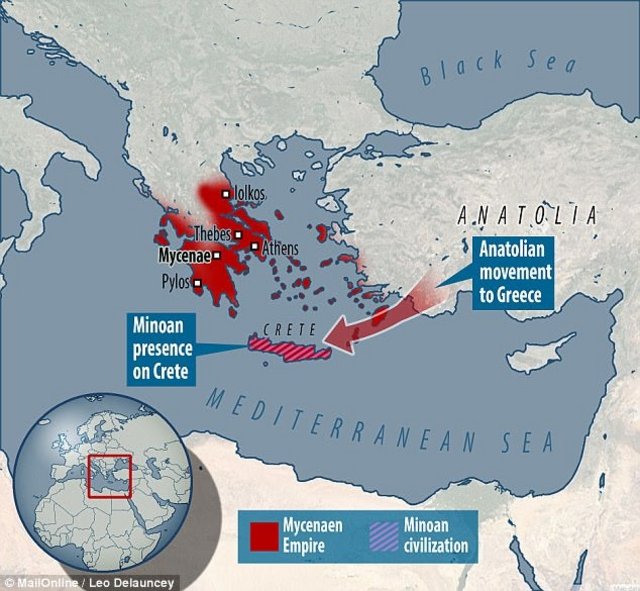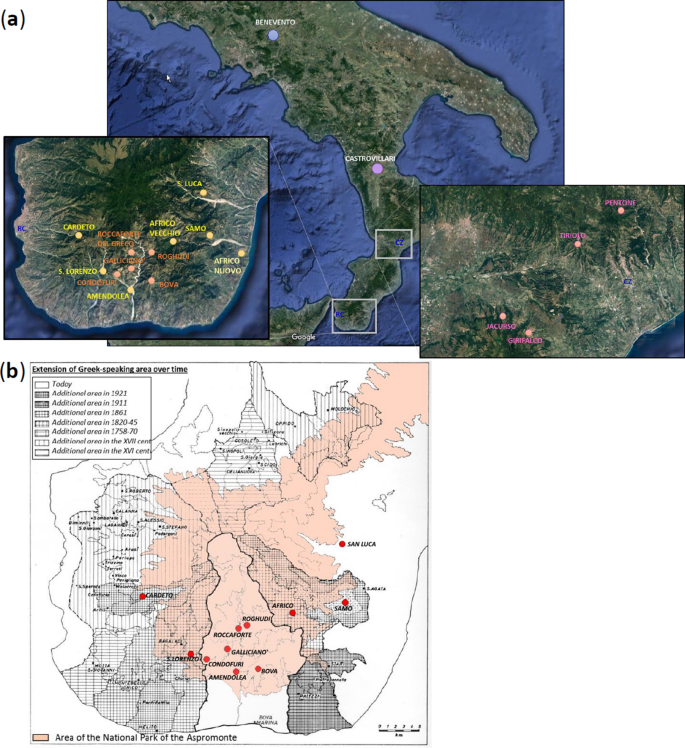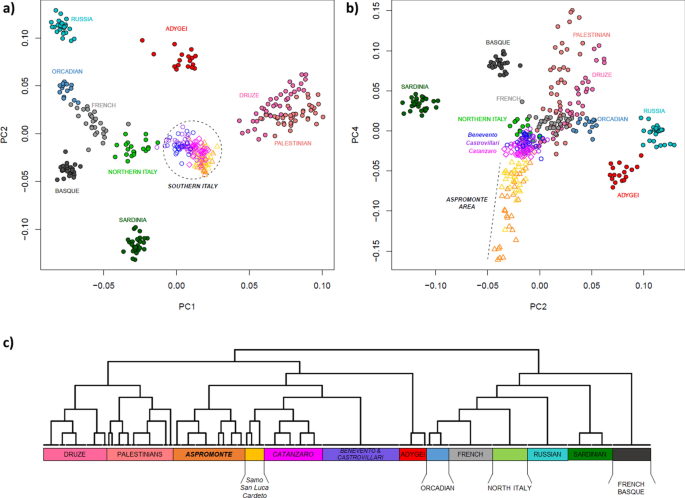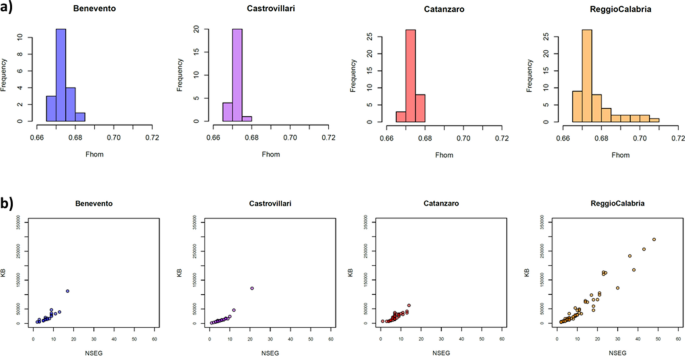Post by Admin on Jul 3, 2020 20:55:53 GMT
Supplementary Information 3
Y-chromosome haplogroup determination
We determined that there were five males in the newly described data using the ratio of sequences
aligning to the X and Y chromosomes1; for sequences with MAPQ≥30, the ratio of Y/(X+Y) was
≥0.13 for the group of five males, but ≤0.02 for the remaining individuals. For the five males we used
ANGSD2to estimate their nuclear contamination based on the presence of heterozygosity on the Xchromosome (of which males have only one copy). Using the same parameters used for calling alleles as were used to analyze this data (MAPQ≥10 and base quality≥20), we determined that none of the males had evidence of substantial contamination (≤1.2%; Table S3.1), except perhaps I9130 (4±3.1% for this lower-quality sample).

Table S3.1: X-chromosome based estimates of contamination in 5 male samples (using new_llh
and MoM estimate in ANGSD)
Individual Estimate of contamination Standard Error
I2495 0.012 0.003
I0070 0.003 0.002
I0073 0.005 0.002
I9041 0.012 0.004
I9130 0.040 0.031
Haplogroup determination
We used the haplogroup terminology of the International Society of Genetic Genealogy
(http://www.isogg.org) v. 9.129 (accessed Dec. 08, 2014). We called genotypes using reads with
MAPQ and base quality ≥30, omitting 2 bases at the ends of reads, and taking the majority allele (as
only one allele should occur at each position of the Y-chromosome in males, minority alleles may
represent ancient DNA damage, sequencing error, or low-level contamination). For each sample, we
determined the most derived SNP as well as downstream SNPs for which the sample was ancestral.
The results are summarized in Table S3.2.
Table S3.2: Y-chromosome haplogroups of male samples
Individual Population Haplogroup
I2495 Anatolia_BA J1a(xJ1a2b)
I0070 Minoan_Lasithi J2a1d
I0073 Minoan_Lasithi J2a1(xJ2a1a, J2a1b1a, J2a1b2, J2a1c, J2a1e, J2a1h, J2a1i)
I9130 Minoan_Odigitria G2a2b2a(xG2a2b2a1b1a2a, G2a2b2a1c1a)
I9041 Mycenaean J2a1(xJ2a1a, J2a1b1, J2a1b2, J2a1c, J2a1e, J2a1g, J2a1h, J2a1i)
We discuss the haplogroup assignments in greater detail below.
I2495 (Bronze Age Anatolia)
Haplogroup J is supported by numerous mutations for this individual (CTS687, PF4505, PF4513,
F1167, F1181, PF4519, PF4521, PF4524, FGC1604, FGC3271, PF4530, L60, F1744, F1826,
CTS4349, F2114, CTS5628, CTS5678, CTS5934, CTS7229, F2502, CTS7483, PF4567, F2746,
PF4575, F2769, CTS8974, F2973, CTS10446, F3119, F4299, S22619, F4300, PF4591, PF4594,
PF4595, PF4598, Z7829, CTS10858, L778, CTS11571, PF4619, CTS12047). One read supports
placement in haplogroup J1a (mutation CTS5368/Z2215:16227302G->A). This individual was
ancestral for the major subclade3 P58 (J1a2b; previously designated3 J1e) and could thus be designated as J1a(xJ1a2b).
I0070 (Minoan from Lasithi)
This individual was derived for mutation M319:15467785T->A (J2a1d) as well as upstream mutations
L26:22942897T->C (J2a1) and M410:2751678A->G, L212:22711465T->C (J2a). He was not found
to be ancestral for any downstream mutations and could be designated as J2a1d. Haplogroup M319
was found4 at a frequency of 8.8% in one sample set of 193 present-day Cretans (95% confidence
interval from the binomial distribution 5.2-13.7%) and 5.4% in another set5
of 168 Cretans (95% C.I.: 2.5-10%), but no examples were found in a combined sample set of 171 Greeks from three locations
near early Neolithic settlements in mainland Greece (95% C.I: 0-2.1%). A re-analysis4 of large set of
523 present-day Anatolian males6 revealed only 2 examples of M319 in this population (95% C.I.: 0-
1.4%). Thus, it appears plausible that this represents a Y-chromosome lineage that existed in Minoan
Crete but was at a lower (or absent) frequency in neighboring mainland Greece and Anatolia and its
occurrence in present-day Cretans represents continuity with those of the Bronze Age.
I0073 (Minoan from Lasithi)
This individual was derived for mutation L26:22942897T->C (J2a1) as well as upstream mutations
M410, L559, L152 (J2a). He was ancestral for several downstream haplogroups: M322:15469740C
>A (J2a1a), L560:21899860C->T (J2a1b1a), M166:21764694C->T (J2a1b2), M68:21878700A->G
(J2a1c), M339:2881367T->G (J2a1e), L24:14286528G->A (J2a1h), L88.2:17595842T->C and
L198:17595861A->C (J2a1i). He could thus be designated as J2a1(xJ2a1a, J2a1b1a, J2a1b2, J2a1c,
J2a1e, J2a1h, J2a1i).
I9130 (Minoan from Moni Odigitria)
This individual was derived for mutations CTS946:7100848A->G (G2a2b2a) and upstream mutations
F3088:20813445G->A and M3397:21605685G->C (G2a). He was ancestral for downstream
mutations CTS4803:15833180G->A (G2a2b2a1b1a2a) and Z3423:19251438G->T (G2a2b2a1c1a).
He could thus be designated as G2a2b2a(xG2a2b2a1b1a2a, G2a2b2a1c1a). G2a2 Y-chromosomes
were common in Neolithic Europe7, western Anatolia8,9, and Neolithic mainland Greece9. We have
also re-analyzed data from a recent study of central Anatolian Neolithic genomes10, determining that
they were present there during both the Aceramic phase at Boncuklu (2 G2a2b2b samples) and later at
Tepecik-Çiftlik (1 G2a2a sample). Plausibly, the Minoan from Moni Odigitria who belonged to this
lineage was also related to the same group of early Neolithic farmers as those from Europe, mainland
Greece, and Anatolia.
I9041 (Mycenaean from Galatas Apatheia in the Peloponnese)
This individual was derived for mutations L26:22942897T->C and F4326:23021978A->G (J2a1) as
well as upstream mutations M410:2751678A->G, L559:21674327A->G, L152:22243566C->T,
L212:22711465T->C (J2a). He was ancestral for M322:15469740C->A (J2a1a), M260:15025506G-
>A and M92:21904023T->C (J2a1b1), M166:21764694C->T (J2a1b2), L210:16492197A->T
(J2a1b3), M68:21878700A->G (J2a1c), M339:2881367T->G (J2a1e), P81:6739856G->A (J2a1g),
L207.1:6753448A->G and L24:14286528G->A (J2a1h), L88.2:17595842T->C and L198:17595861A->C (J2a1i).
He could thus be designated as J2a1x(J2a1a, J2a1b1, J2a1b2, J2a1c, J2a1e, J2a1g, J2a1h, J2a1i).
Discussion
Our results highlight the importance of haplogroup J chromosomes during the Bronze Age in
mainland Greece, Crete, and Anatolia, in contrast to the earlier Neolithic populations that were
dominated by haplogroup G2a2. We cannot exclude an earlier presence of haplogroup J chromosomes
in the region, but we note that in the large population sample from northwestern Anatolia8
(n=15 males) we discovered a single J2a male which did not differ in his autosomal profile from other
individuals in that population. By contrast 4 of 5 individuals from the Bronze Age in our study
belonged to haplogroup J. Both Caucasus hunter-gatherers of Paleolithic-to-Mesolithic time depth
belonged11 to haplogroup J, as did a Mesolithic and a Chalcolithic sample from Iran12 and a huntergatherer
from northeast Russia8. Haplogroup J (and especially J2) chromosomes are today common in present-day
Anatolia6 and Greece (including the mainland and Crete)4,5,13-16.
It was previously associated with the diffusion of Neolithic farmers into Europe17 and its J2 and J1 clades with
agriculturalist vs. pastoralist Neolithic pioneers (based on geographical/climatic correlations)18.
Our results suggest a later westward dispersal than the Neolithic farming expansion and raise questions
about the cause of this dispersal.

More sampling of ancient populations is needed to establish the presence (and frequency) of
haplogroup J in the Aegean and neighboring regions).
However, (i) the great time depth of its presence in the Caucasus/Iran, together with (ii) its low frequency/absence in Neolithic Greece/Anatolia, and (iii) its appearance in the samples of our study, lead us to believe that it may have accompanied the genetic admixture (Neolithic Iran/Caucasus-hunter-gatherer related) that seems to have affected all populations in our study (Supplementary Information, section 2). Thus, the Ychromosome turnover that occurred in central Europe during the Bronze Age7,19 may also have occurred in the Aegean, with a different set of incoming lineages.
Y-chromosome haplogroup determination
We determined that there were five males in the newly described data using the ratio of sequences
aligning to the X and Y chromosomes1; for sequences with MAPQ≥30, the ratio of Y/(X+Y) was
≥0.13 for the group of five males, but ≤0.02 for the remaining individuals. For the five males we used
ANGSD2to estimate their nuclear contamination based on the presence of heterozygosity on the Xchromosome (of which males have only one copy). Using the same parameters used for calling alleles as were used to analyze this data (MAPQ≥10 and base quality≥20), we determined that none of the males had evidence of substantial contamination (≤1.2%; Table S3.1), except perhaps I9130 (4±3.1% for this lower-quality sample).

Table S3.1: X-chromosome based estimates of contamination in 5 male samples (using new_llh
and MoM estimate in ANGSD)
Individual Estimate of contamination Standard Error
I2495 0.012 0.003
I0070 0.003 0.002
I0073 0.005 0.002
I9041 0.012 0.004
I9130 0.040 0.031
Haplogroup determination
We used the haplogroup terminology of the International Society of Genetic Genealogy
(http://www.isogg.org) v. 9.129 (accessed Dec. 08, 2014). We called genotypes using reads with
MAPQ and base quality ≥30, omitting 2 bases at the ends of reads, and taking the majority allele (as
only one allele should occur at each position of the Y-chromosome in males, minority alleles may
represent ancient DNA damage, sequencing error, or low-level contamination). For each sample, we
determined the most derived SNP as well as downstream SNPs for which the sample was ancestral.
The results are summarized in Table S3.2.
Table S3.2: Y-chromosome haplogroups of male samples
Individual Population Haplogroup
I2495 Anatolia_BA J1a(xJ1a2b)
I0070 Minoan_Lasithi J2a1d
I0073 Minoan_Lasithi J2a1(xJ2a1a, J2a1b1a, J2a1b2, J2a1c, J2a1e, J2a1h, J2a1i)
I9130 Minoan_Odigitria G2a2b2a(xG2a2b2a1b1a2a, G2a2b2a1c1a)
I9041 Mycenaean J2a1(xJ2a1a, J2a1b1, J2a1b2, J2a1c, J2a1e, J2a1g, J2a1h, J2a1i)
We discuss the haplogroup assignments in greater detail below.
I2495 (Bronze Age Anatolia)
Haplogroup J is supported by numerous mutations for this individual (CTS687, PF4505, PF4513,
F1167, F1181, PF4519, PF4521, PF4524, FGC1604, FGC3271, PF4530, L60, F1744, F1826,
CTS4349, F2114, CTS5628, CTS5678, CTS5934, CTS7229, F2502, CTS7483, PF4567, F2746,
PF4575, F2769, CTS8974, F2973, CTS10446, F3119, F4299, S22619, F4300, PF4591, PF4594,
PF4595, PF4598, Z7829, CTS10858, L778, CTS11571, PF4619, CTS12047). One read supports
placement in haplogroup J1a (mutation CTS5368/Z2215:16227302G->A). This individual was
ancestral for the major subclade3 P58 (J1a2b; previously designated3 J1e) and could thus be designated as J1a(xJ1a2b).
I0070 (Minoan from Lasithi)
This individual was derived for mutation M319:15467785T->A (J2a1d) as well as upstream mutations
L26:22942897T->C (J2a1) and M410:2751678A->G, L212:22711465T->C (J2a). He was not found
to be ancestral for any downstream mutations and could be designated as J2a1d. Haplogroup M319
was found4 at a frequency of 8.8% in one sample set of 193 present-day Cretans (95% confidence
interval from the binomial distribution 5.2-13.7%) and 5.4% in another set5
of 168 Cretans (95% C.I.: 2.5-10%), but no examples were found in a combined sample set of 171 Greeks from three locations
near early Neolithic settlements in mainland Greece (95% C.I: 0-2.1%). A re-analysis4 of large set of
523 present-day Anatolian males6 revealed only 2 examples of M319 in this population (95% C.I.: 0-
1.4%). Thus, it appears plausible that this represents a Y-chromosome lineage that existed in Minoan
Crete but was at a lower (or absent) frequency in neighboring mainland Greece and Anatolia and its
occurrence in present-day Cretans represents continuity with those of the Bronze Age.
I0073 (Minoan from Lasithi)
This individual was derived for mutation L26:22942897T->C (J2a1) as well as upstream mutations
M410, L559, L152 (J2a). He was ancestral for several downstream haplogroups: M322:15469740C
>A (J2a1a), L560:21899860C->T (J2a1b1a), M166:21764694C->T (J2a1b2), M68:21878700A->G
(J2a1c), M339:2881367T->G (J2a1e), L24:14286528G->A (J2a1h), L88.2:17595842T->C and
L198:17595861A->C (J2a1i). He could thus be designated as J2a1(xJ2a1a, J2a1b1a, J2a1b2, J2a1c,
J2a1e, J2a1h, J2a1i).
I9130 (Minoan from Moni Odigitria)
This individual was derived for mutations CTS946:7100848A->G (G2a2b2a) and upstream mutations
F3088:20813445G->A and M3397:21605685G->C (G2a). He was ancestral for downstream
mutations CTS4803:15833180G->A (G2a2b2a1b1a2a) and Z3423:19251438G->T (G2a2b2a1c1a).
He could thus be designated as G2a2b2a(xG2a2b2a1b1a2a, G2a2b2a1c1a). G2a2 Y-chromosomes
were common in Neolithic Europe7, western Anatolia8,9, and Neolithic mainland Greece9. We have
also re-analyzed data from a recent study of central Anatolian Neolithic genomes10, determining that
they were present there during both the Aceramic phase at Boncuklu (2 G2a2b2b samples) and later at
Tepecik-Çiftlik (1 G2a2a sample). Plausibly, the Minoan from Moni Odigitria who belonged to this
lineage was also related to the same group of early Neolithic farmers as those from Europe, mainland
Greece, and Anatolia.
I9041 (Mycenaean from Galatas Apatheia in the Peloponnese)
This individual was derived for mutations L26:22942897T->C and F4326:23021978A->G (J2a1) as
well as upstream mutations M410:2751678A->G, L559:21674327A->G, L152:22243566C->T,
L212:22711465T->C (J2a). He was ancestral for M322:15469740C->A (J2a1a), M260:15025506G-
>A and M92:21904023T->C (J2a1b1), M166:21764694C->T (J2a1b2), L210:16492197A->T
(J2a1b3), M68:21878700A->G (J2a1c), M339:2881367T->G (J2a1e), P81:6739856G->A (J2a1g),
L207.1:6753448A->G and L24:14286528G->A (J2a1h), L88.2:17595842T->C and L198:17595861A->C (J2a1i).
He could thus be designated as J2a1x(J2a1a, J2a1b1, J2a1b2, J2a1c, J2a1e, J2a1g, J2a1h, J2a1i).
Discussion
Our results highlight the importance of haplogroup J chromosomes during the Bronze Age in
mainland Greece, Crete, and Anatolia, in contrast to the earlier Neolithic populations that were
dominated by haplogroup G2a2. We cannot exclude an earlier presence of haplogroup J chromosomes
in the region, but we note that in the large population sample from northwestern Anatolia8
(n=15 males) we discovered a single J2a male which did not differ in his autosomal profile from other
individuals in that population. By contrast 4 of 5 individuals from the Bronze Age in our study
belonged to haplogroup J. Both Caucasus hunter-gatherers of Paleolithic-to-Mesolithic time depth
belonged11 to haplogroup J, as did a Mesolithic and a Chalcolithic sample from Iran12 and a huntergatherer
from northeast Russia8. Haplogroup J (and especially J2) chromosomes are today common in present-day
Anatolia6 and Greece (including the mainland and Crete)4,5,13-16.
It was previously associated with the diffusion of Neolithic farmers into Europe17 and its J2 and J1 clades with
agriculturalist vs. pastoralist Neolithic pioneers (based on geographical/climatic correlations)18.
Our results suggest a later westward dispersal than the Neolithic farming expansion and raise questions
about the cause of this dispersal.

More sampling of ancient populations is needed to establish the presence (and frequency) of
haplogroup J in the Aegean and neighboring regions).
However, (i) the great time depth of its presence in the Caucasus/Iran, together with (ii) its low frequency/absence in Neolithic Greece/Anatolia, and (iii) its appearance in the samples of our study, lead us to believe that it may have accompanied the genetic admixture (Neolithic Iran/Caucasus-hunter-gatherer related) that seems to have affected all populations in our study (Supplementary Information, section 2). Thus, the Ychromosome turnover that occurred in central Europe during the Bronze Age7,19 may also have occurred in the Aegean, with a different set of incoming lineages.




